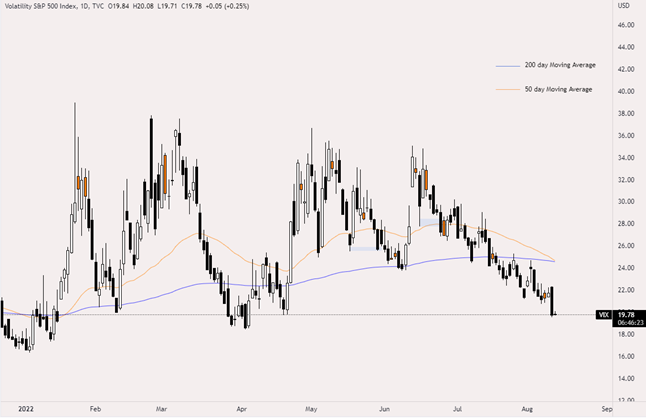S&P: The Long Straddle
On Wednesday 10th August 2022 markets rejoiced with the US core inflation rate being lower than forecasted. Today (Friday 12 August 2022) the VIX index is priced below 20. The VIX is a general measure of volatility in the US stock market and has been aggressively fluctuating between 18.5 and 37 in the past 100 days. The index is also currently several points below the 100- and 200-day moving average, alluding to the possibility that an upcoming surge in volatility is likely.
Two historically reliable predictors of recessions are the inversion of the US bond yields and annual negative GDP growth. Last Monday, we saw the Treasury yield curve being the most deeply inverted in 22 years, the 2-year Treasury yield traded at a premium of 45.1 basis points over the 10-year. Additionally, US GDP is also falling at an annualised rate of 1.6%. As well as these recessionary indicators, geopolitical uncertainty at the hands of Russia and China, precious metal markets rising illustrating demand for a safe haven, and critically low water levels in waterways imperative for trade, are enough confluences to suggest anything but smooth sailing for the US stock market.
How can we take advantage of this?
We can buy an Index straddle, allowing us to profit from an increase in market volatility. A long straddle is a strategy in which you buy a call option and a put option, typically at the money, both with the same strike price and expiration. Current index volatility being particularly low relative to its moving average, makes this an ideal time to execute this trade as you will pay less for the two options because of lower implied volatility.
Long Straddle
Trade Summary
Buying a Sep22 S&P 500 index Straddle with a strike price of 4240 and paying a total of $190 in premium for the two options
$50 per point: 50 x 190 x 1 = $9500 total cost
If the index moves sharply in either direction to say, 3640 or 4840 before expiration of the options then you will make a profit of $410 ($20,500) .The worst-case scenario here is if the index doesn’t move and remains at exactly 4240 between now and its expiry, the options will then expire worthless and you lose the $190 ($9,500) that you paid for the strategy. You can also trade this tactically by selling the call when the market goes up and then selling the put when the market retraces.

